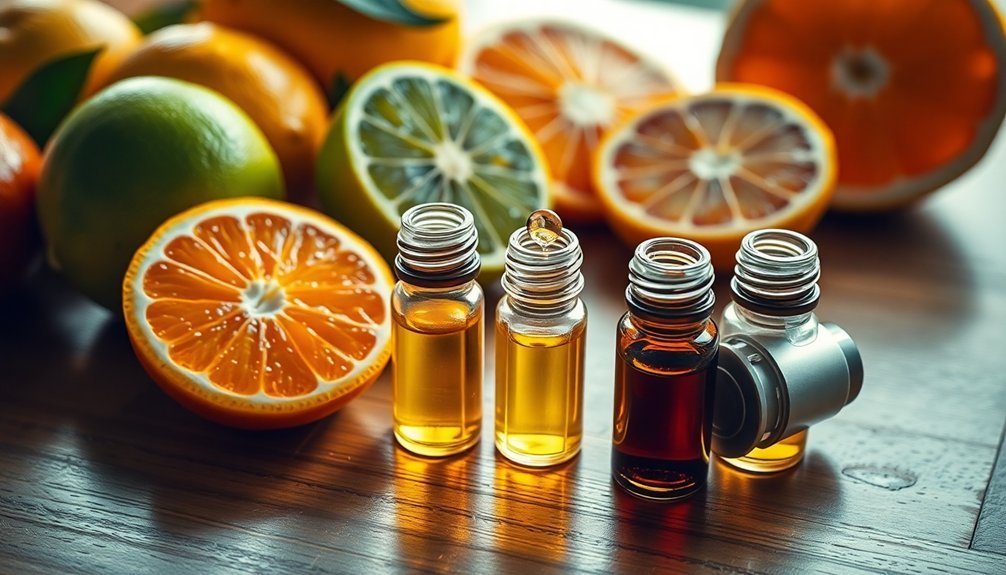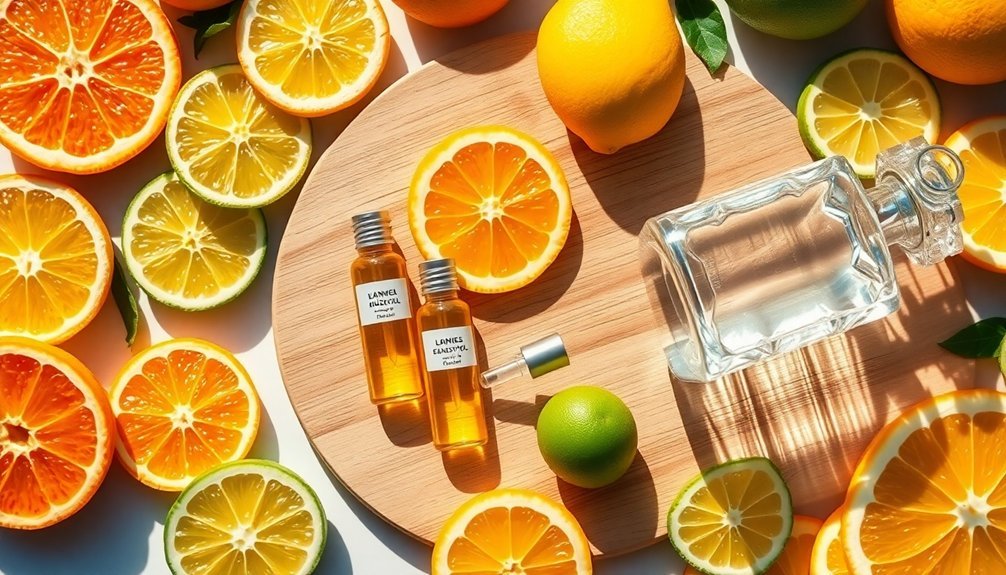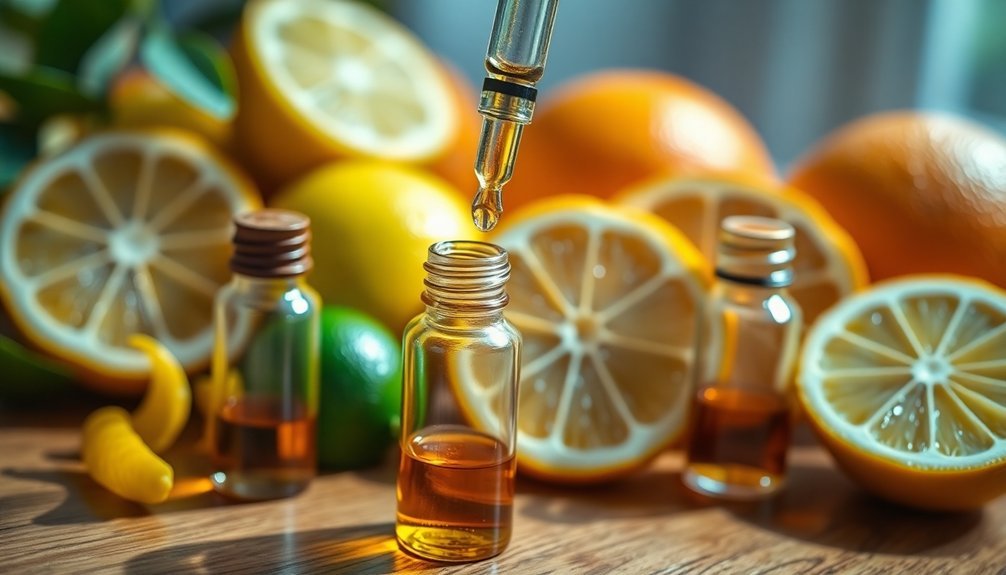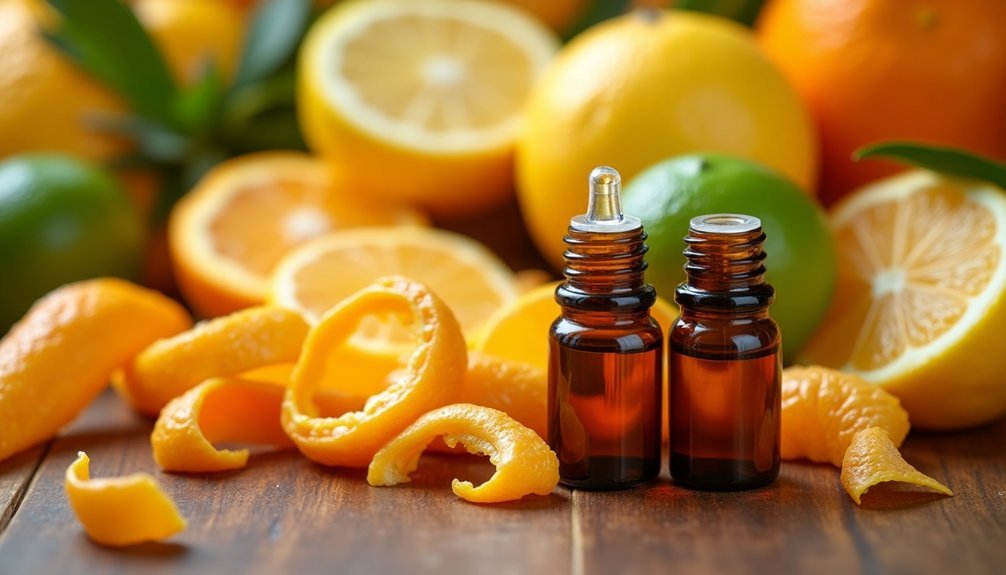To layer citrus essential oils like a master perfumer, start with grounding base notes like sandalwood or cedarwood. Next, add middle notes that complement your citrus profile, such as jasmine or rosemary. Finally, top with vibrant citrus oils like lemon, grapefruit, or sweet orange. Allow 30-60 seconds between layers for proper absorption, and use dark glass containers with quality droppers for precise measurements. Mastering these foundational techniques will reveal endless possibilities for creating your signature citrus fragrances.
Understanding the Art of Citrus Oil Layering

When exploring the art of citrus oil layering, you'll discover it's much like composing a symphony of scents, where each note plays an essential role in creating a harmonious blend. The secret lies in understanding how different notes interact and evolve over time. Uplifting and energizing effects are characteristic of citrus oils in aromatherapy.
Start with your base notes like cedarwood or sandalwood to create a strong foundation that anchors your blend.
Then, add middle notes to form the heart of your fragrance, selecting complementary floral or herbal oils that enhance your citrus profile.
Finally, crown your creation with vibrant top notes like lemon, grapefruit, or sweet orange for that initial burst of freshness.
Remember that each oil reacts uniquely with your skin chemistry, so don't hesitate to adjust ratios until you find your perfect balance. A good starting point is a 3:2:1 ratio of base, middle, and top notes.
Essential Tools and Materials for Your Citrus Blend
You'll need amber or cobalt glass bottles to protect your citrus essential oils from light degradation and preserve their therapeutic properties.
Consider using only 100% pure essential oils like our Citrus Carol blend to ensure the highest quality results when creating your custom fragrances.
Invest in high-quality glass droppers and pipettes to guarantee precise measurements and prevent cross-contamination between oils.
When selecting carrier oils for your citrus blends, opt for light, non-greasy options like jojoba or sweet almond oil, which complement the fresh nature of citrus oils while providing proper dilution.
Dark Glass Storage Containers
Dark glass storage containers serve as the backbone of proper essential oil preservation, especially for citrus blends that are particularly sensitive to light exposure. You'll want to invest in amber or green glass bottles with euro dropper lids for your citrus layering projects. Our selection includes sets of four bottles in both 10ml and 30ml sizes to accommodate different blending needs.
| Container Type | Best For | Why You'll Love It |
|---|---|---|
| Amber Bottles | Daily Use | Classic protection |
| Green Glass | Long-term Storage | Extra UV defense |
| Roll-on Bottles | Topical Blends | Easy application |
| Spray Bottles | Room Mists | Even distribution |
| Dropper Bottles | Precise Mixing | Perfect portions |
Don't compromise by using plastic containers, as they can react with your precious oils. Keep your citrus blends in a cool, dark place, and always guarantee the caps are tightly sealed. For convenience, consider using a storage box to organize your collection while providing an extra layer of light protection.
Quality Droppers and Pipettes
Three essential tools form the foundation of precise citrus oil blending: quality droppers, pipettes, and measuring devices. Since citrus oils are typically thinner than other essential oils, you'll need accurate tools to prevent waste and guarantee consistent results.
Choose glass pipette droppers for your 5ml and 10ml bottles, as they're leakproof and easy to clean. For more precise measurements, opt for measuring stem pipettes marked in 0.5ml increments. Remember that drop sizes vary considerably between oils due to differences in viscosity, so don't rely on orifice reducers alone.
When working with citrus blends, you'll want detachable pipettes that you can clean thoroughly between uses. They'll help you avoid cross-contamination and maintain the purity of your oils while giving you professional-level control over your measurements.
Carrier Oil Selection Guide
Selecting the right carrier oil forms the cornerstone of successful citrus oil blending. For your citrus creations, consider using grape seed oil as your primary carrier, as it's lightweight and won't compete with your citrus scents. It's also an excellent choice if you're concerned about nut allergies.
If you're creating a skin-focused blend, jojoba oil makes an ideal carrier since it mimics your skin's natural oils. For those seeking deeper moisturizing benefits, avocado oil's nutrient-rich profile works wonderfully with citrus oils.
When choosing your carrier, remember to check the comedogenic rating to prevent clogged pores, and always store your oils in a cool, dark place. Before starting your blend, verify you're using fresh, high-quality carriers, preferably organic or cold-pressed, to maintain the integrity of your citrus creation.
The Science Behind Citrus Oil Notes
Understanding citrus oil notes begins with their complex chemical composition, where limonene serves as the dominant component across various citrus sources.
You'll find that monoterpene hydrocarbons like D-limonene, β-pinene, and γ-terpinene create the characteristic fresh, zesty aroma you recognize in citrus oils.
When you're working with citrus notes, you're actually experiencing a sophisticated interplay of compounds like citronellal, myrcene, and sabinene.
These components don't just contribute to the scent – they're responsible for the oils' biological activities. The concentration of these compounds varies greatly between fruit peels and leaves, which explains why a lemon leaf oil smells distinctly different from lemon peel oil.
Scientists use GC-MS analysis to precisely identify these variations, helping perfumers create more nuanced layering combinations.
Step-by-Step Layering Technique

You'll want to start your citrus oil layering with a solid base note like bergamot, taking time to massage it into your skin before proceeding.
Once your base is set, add your middle notes such as lemon or lime, allowing each layer to absorb for 30-60 seconds.
Finally, complete your blend with lighter top notes like grapefruit or orange, followed by a carrier oil to seal in the benefits and protect your skin.
Prepare Your Base Layer
To create a lasting citrus fragrance, starting with the right base layer is essential.
Begin by selecting a grounding base note like vetiver, sandalwood, or patchouli that'll complement your citrus blend. Add a few drops of your chosen base oil to a glass roller bottle or perfume vial.
If you're applying directly to your skin, dilute the base note with a carrier oil to prevent irritation. Apply the base layer to pulse points like your wrists or behind your ears, and give it time to absorb before adding other layers.
You'll want to ascertain your chosen base note is skin-compatible by performing a patch test first. Consider using a heavy lotion or body butter to help fix the scent and extend its longevity throughout the day.
Master The Middle Notes
Once your base layer has settled, it's time to build the heart of your fragrance with middle notes. Select citrus-complementary middle notes that'll create a seamless shift between your base and upcoming top notes. Apply these heart notes carefully, as they'll comprise 50-75% of your blend and determine its overall character.
| Middle Note | Properties | Pairing Suggestion |
|---|---|---|
| Geranium | Floral, Sweet | Bergamot |
| Cardamom | Spicy, Warm | Orange |
| Lavender | Herbaceous | Lemon |
| Clary Sage | Herbal, Earthy | Grapefruit |
| Black Pepper | Spicy, Sharp | Lime |
Use a diffuser to spread these middle notes evenly, or apply them directly after your base layer for topical use. Document your combinations and ratios to replicate successful blends. Remember, these notes will last several hours, so choose ones that maintain your desired fragrance profile.
Complete With Top Notes
The final step in creating your layered citrus fragrance brings us to the vibrant top notes.
These bright, invigorating oils will give your blend its initial impact, lasting about 15-30 minutes. You'll want to select from classic citrus oils like lime, lemon, and bergamot, or explore unique options like grapefruit and yuzu for a distinctive touch.
- Start with 2-3 drops of your chosen citrus oil on a cotton ball for direct inhalation, or add to your diffuser after your base and middle notes.
- Combine different citrus oils to create complexity – try bergamot with neroli for a sophisticated blend.
- Mix with a carrier oil like jojoba when applying to skin.
- Layer your citrus oils over middle notes, allowing each layer to settle for ideal fragrance development.
Creating Your Signature Citrus Fragrance

Creating a signature citrus fragrance lets you express your personality while harnessing the vibrant qualities of these energizing oils. Start by mixing different citrus notes – try pairing sweet orange with zesty grapefruit or bright lemon with smooth bergamot.
You'll want to experiment gradually, adding just a few drops at a time until you achieve your perfect blend.
To add complexity and staying power to your creation, incorporate complementary green notes like mint or grounding base notes with a touch of musk.
Don't forget to record your winning combinations as you go. Store your custom blend in a dark glass container to preserve its quality, and always dilute it with carrier oils like jojoba or sweet almond before applying to your skin.
Remember to patch test your creation to verify skin compatibility.
Optimal Oil Combinations for Different Moods
Selecting the right citrus oil combinations can considerably influence your emotional well-being throughout the day.
You'll find that different blends serve specific purposes, from energizing your morning routine to helping you unwind in the evening. By understanding these combinations, you can create targeted aromatherapy experiences that match your desired mood.
- For morning energy: Blend orange and peppermint oils to kickstart your day with mental clarity and focus.
- During stressful moments: Mix bergamot with frankincense to create a grounding, calming atmosphere.
- For afternoon focus: Combine rosemary with lemon to maintain concentration and alertness.
- Before bedtime: Layer mandarin with lavender or sandalwood for a gentle shift into evening relaxation.
These strategic combinations will help you harness the full potential of citrus oils for mood enhancement.
Perfecting Your Application Methods

While understanding oil combinations sets the foundation for aromatherapy success, mastering proper application techniques maximizes their therapeutic benefits. Start by conducting a patch test, then follow the essential layering sequence of base notes first, middle notes second, and top notes last.
| Application Method | Key Tips |
|---|---|
| Diffusing | Start with base notes, add middle and top notes gradually |
| Topical | Dilute with carrier oil, apply one at a time |
| Inhalation | Use cotton ball for direct benefits |
For topical applications, dilute your citrus oils using a 3:2:1 ratio (base:middle:top) with carrier oils like jojoba or sweet almond. Apply to pulse points such as wrists and neck, massaging each layer for 30-60 seconds before adding the next. Remember to document successful combinations to recreate your favorite blends.
Preserving and Storing Your Citrus Creations
Proper storage techniques can dramatically extend the life and potency of your citrus essential oil blends. Given their high limonene content, these oils are particularly sensitive to environmental factors and require special care to maintain their therapeutic properties.
For ideal preservation of your citrus creations, follow these essential guidelines:
- Store your blends in dark glass bottles at 45-50°F (7-10°C), ideally in a refrigerator, to prevent oxidation and maintain potency.
- Keep your oils in airtight containers away from direct sunlight and heat sources to avoid phototoxic reactions.
- Choose a consistent, dry storage environment to protect against humidity damage.
- Monitor your blends regularly for signs of deterioration, as citrus oils typically last 1-2 years when stored properly.
Remember that proper storage isn't just about longevity – it's vital for maintaining safety and effectiveness in your aromatherapy practice.
Frequently Asked Questions
Can Pregnant Women Safely Layer Citrus Essential Oils?
You can safely layer pregnancy-approved citrus oils like lemon, grapefruit, and mandarin, but you'll need to use a diffuser or dilute them properly. Always consult your healthcare provider first for personalized guidance.
How Long Does a Layered Citrus Oil Fragrance Typically Last?
When you layer citrus oils, you'll get 2-4 hours of fragrance, depending on your blending technique. If you've combined them with middle and base notes, they'll last considerably longer on your skin.
Will Citrus Oils Stain My Clothes When Layered?
Yes, citrus oils can stain your clothes if they're not properly handled. You'll want to apply them directly to your skin and let them dry before dressing. If spills happen, wash the fabric immediately.
Can I Layer Citrus Oils With Synthetic Fragrances?
Yes, you can layer citrus oils with synthetic fragrances, but you'll need proper solubilization and careful ratio testing. Start with small amounts and let each layer dry to prevent scent clashing or instability.
Do Citrus Oils Increase Sun Sensitivity When Layered?
Yes, layered citrus oils will still increase your sun sensitivity due to furanocoumarins. You'll need to avoid sun exposure for up to 36 hours, regardless of whether you've layered them with other fragrances.
In Summary
You're now equipped to create stunning citrus fragrance combinations like a professional perfumer. With your knowledge of top, middle, and base notes, plus proper layering techniques, you'll craft unique scents that truly represent your style. Remember to store your creations properly and keep experimenting with different ratios and combinations. Trust your nose, follow your instincts, and let your citrus masterpieces shine through every blend you create.
References
- https://www.heavenlypureoils.com/post/uncovering-the-power-of-layering-essential-oils-maximizing-benefits
- https://www.powersaromatherapy.com/2020/05/02/what-does-it-mean-to-layer-essential-oils/
- https://mdpi-res.com/bookfiles/book/9622/Fine_Chemicals_from_Natural_Sources_with_Potential_Application_in_the_CosmeticPharmaceutical_Industry.pdf?v=1736388430
- https://www.freshskin.co.uk/blog/essential-oils-blending-guide/
- https://hotoilymumma.com.au/essential-oils/layering-essential-oils/
- https://vriaroma.com/blog/137/the-art-of-scent-layering-how-to-combine-essential-oils-for-a-personalized-fragrance-experience
- https://github.com/tatsu-lab/alpaca_eval/blob/main/results/baize-v2-13b/model_outputs.json
- https://www.newdirectionsaromatics.com/blog/the-theory-practice-of-essential-oil-blending/
- https://www.homedics.com/citrus-carol-essential-oil-blend-15-ml/
- https://www.candlewarmers.com/products/citrus-boost-essential-oil-blend/





Leave a Reply